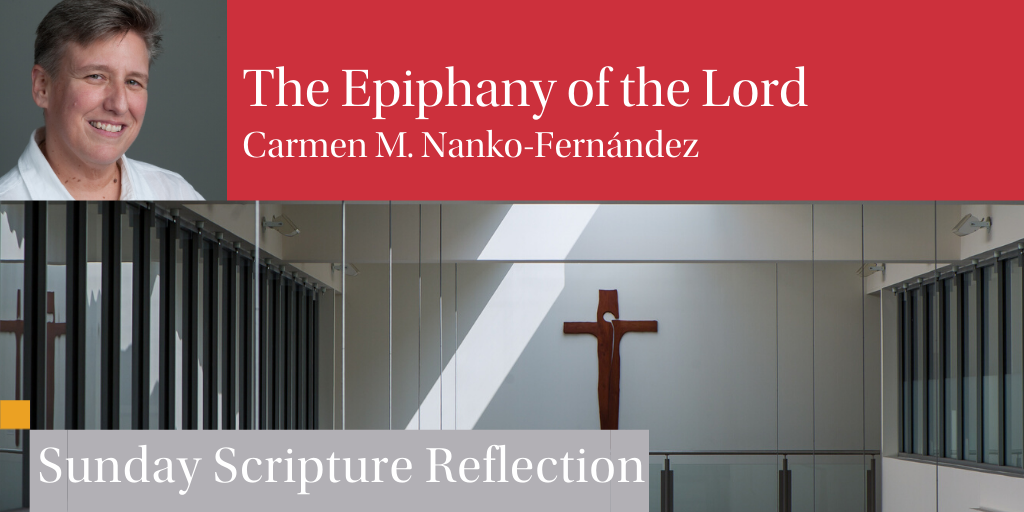

Readings:
First Reading: Isaiah 60: 1-6
Responsorial Psalm: 72: 1-2, 7-8, 10-11, 12-13
Second Reading: Ephesians 3: 2-3A, 5-6
Gospel: Matthew 2: 1-12
For millennia, the tale of the magi and their visit to Bethlehem have captivated the Christian popular imagination. Little is actually known about their identities, individually or collectively, leaving lots of room for creative musings, scholarly speculations, theological interpretations, and threads of narrative and artistic expressions across time and cultures. These mysterious travelers bearing gifts have accreted reputations as wisdom figures, royalty, and star gazers. Their numbers have ranged from two through twelve, in various retellings, though the quantity of gifts has established three as an acceptable accounting of their company. Over the centuries they acquired names and backstories, so familiar to many, that some Christians do not recognize that these are lives created beyond the gospel material.
These magi are in constant motion! In the gospel they arrive in Jerusalem, they set out for Bethlehem on the word of Herod, they depart for their own land by an alternate route. In art, especially as evident in Christmas cards, they are often depicted in motion, in transit, moving toward their star-determined goal. Even in their afterlife, in popular traditions, they are mobile. Their alleged remains are moved to Constantinople and Milan before finding a home in the Cathedral at Köln Germany in what is believed to be the largest medieval reliquary. In Puerto Rico the most famous trio annually head out across the island from the town of Juana Díaz distributing gifts for several days to the kids who await their arrival in their own pueblos. In 2004 these Puerto Rican Reyes Magos even visited the Vatican where they were blessed by Pope John Paul II. In New York City they parade down Park Avenue, with their camels, courtesy of El Museo del Barrio. This year the 43rd annual celebration appropriately honors the city’s immigrant and migrant communities — past and present, in other words people on the move.
Archaeologists and art historians contend that depictions of the magi predate those of the nativity. As early as the third century their images graced funerary art in cemeteries and catacombs (Jensen). Typical iconography showed them “bearing their gifts and moving in rhythmic procession” towards the Christ child on the lap of his seated Mother (Harley-McGowan and McGowan).
The magi are not the only ones in motion in the second chapter of the gospel of Matthew. The hints of danger can easily be overlooked in our celebration of the Epiphany. The journey of the magi is the reverse of the trajectory of the life of Jesus which begins in Bethlehem and ends in Jerusalem. Divine revelation occurs in troubled times marked by fear-driven flight (Matt 2: 13-15), government sanctioned massacre of children (Matt 2: 16 – 18), a wary return home (Matt 2: 19-23). Set in motion by hopeful promise, the consequences of their quest appears to bear a tremendous cost. Whether the magi were learned, or sovereigns, or interpreters of the heavens, there is no neutral or positive spin that can be culled from the last words of today’s gospel, “having been warned in a dream not to return to Herod they departed for their country by another way” (Matt. 2:12).
While there are countless images of the magi journeying toward their encounter with the divine, and innumerable and memorable depictions of their adoration, my memory finds it impossible to recall a visual of their detoured departure and its aftermath. Some early apocryphal texts attempted to fill in gaps, and, perhaps, influenced fanciful medieval legends. For the most part, however, contemporary Christians seem comfortable remaining focused on a journey that ends in gifts and homage avoiding the vexing intimations of danger and the implications of shifts in direction.
Recently, I came upon a digital photo I had taken two years ago of my parents and my aunt on what turned out to be our last Christmas with our family entirely intact. It is a candid shot, unposed and unpretentious, as is evident from the expressions on their faces. Seated together they remind me of the magi, learned-with the wisdom of each of their nine decades of lived experience. Peeking over their right shoulders, toward the end of the frame, is a manger. Its proportionately smaller size gives the illusion of distance, an image of magi returning home. There are intimations of motion in the shot, a cane and wheelchairs subtly make their presence known. The joys of the season provide background, yet their unguarded countenances reveal as well the ambiguities, struggles and sufferings that accompany hope, which marks life lived in all of its complexities. In the faces of my elders I imagine the questions that the magi pondered on their return, in the afterglow of their encounter yet in light of their warning dream.

In the image of the magi of nuestra familia I get a sense as to why early Christian art may have favored the Epiphany motif as funerary art. Professor Robin Jensen, a scholar of Christian art, draws our attention to a curious pairing of the magi with a miracle of Jesus raising the dead on a fourth-century marble sarcophagus. She observes, “In recognizing the promise of a messiah who was both human and divine-and eternal-the magi provided a message of hope for both the living and the dead.” In the motion of the magi, a journey towards and away from Bethlehem, we can feel the rhythmic procession of our own lives touched by the radiance of divine encounter and charged to live it out justly, with and for others, especially in unsettling times, aware of potential risks and costs. Revelation requires an embodied response in motion, a going forth and a return. An encounter with the Word-made-flesh is not only an experience of the divine, it is an encounter with our own humanity.